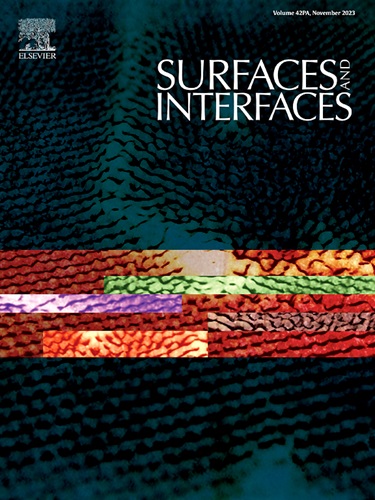Photochromic−activity relationship insights for boosting C(sp3)-H Bonds activation in the BiOBr1-xIx colloid ultrathin nanosheets
IF 5.7
2区 材料科学
Q2 CHEMISTRY, PHYSICAL
引用次数: 0
Abstract
Converting volatile organic compounds like ethylbenzene through C![]() H bond activation to high-value organic intermediates under milder, energy-efficient conditions offers a sustainable approach to chemical synthesis and environmental protection. However, the activation of C(sp3)-H bonds in ethylbenzene poses significant challenges due to their high bond strength and low polarity. Here, we developed iodine-doped photochromic BiOBr1-xIx ultrathin nanosheets as photocatalysts to enhance the photooxidation process under visible light. Iodine doping optimizes the energy band structure and enriches the generation of oxygen vacancies of BiOBr1-xIx nanosheets, endowing pronounced photochromic behavior upon 450 nm light irradiation. The photochromism induced colored state effectively reduces energy waste by suppressing the recombination of photogenerated carriers, thereby increasing solar energy utilization. As the photochromic property of BiOBr1-xIx nanosheets intensifies, the carriers’ separation efficiency improves and thus results in significantly enhanced photooxidation activity of the C
H bond activation to high-value organic intermediates under milder, energy-efficient conditions offers a sustainable approach to chemical synthesis and environmental protection. However, the activation of C(sp3)-H bonds in ethylbenzene poses significant challenges due to their high bond strength and low polarity. Here, we developed iodine-doped photochromic BiOBr1-xIx ultrathin nanosheets as photocatalysts to enhance the photooxidation process under visible light. Iodine doping optimizes the energy band structure and enriches the generation of oxygen vacancies of BiOBr1-xIx nanosheets, endowing pronounced photochromic behavior upon 450 nm light irradiation. The photochromism induced colored state effectively reduces energy waste by suppressing the recombination of photogenerated carriers, thereby increasing solar energy utilization. As the photochromic property of BiOBr1-xIx nanosheets intensifies, the carriers’ separation efficiency improves and thus results in significantly enhanced photooxidation activity of the C![]() H bonds, exhibiting a strong relationship between the photochromic and photocatalytic properties. The photochromic-related photocatalytic coupling and oxidation reactions of ethylbenzene were efficiently realized by BiOBr0.98I0.02 nanosheets catalytic performance approach 7 times compared to pristine BiOBr. Under 450 nm light irradiation for 15 h, the turnover number (TON) of ethylbenzene reaches 274,000 µmol·g⁻¹, with acetophenone selectivity consistently exceeding 99 %. The apparent quantum yield (AQY) at 450 nm is calculated to be 1.3 %. This work highlights a green and sustainable strategy to design new photocatalysts for C
H bonds, exhibiting a strong relationship between the photochromic and photocatalytic properties. The photochromic-related photocatalytic coupling and oxidation reactions of ethylbenzene were efficiently realized by BiOBr0.98I0.02 nanosheets catalytic performance approach 7 times compared to pristine BiOBr. Under 450 nm light irradiation for 15 h, the turnover number (TON) of ethylbenzene reaches 274,000 µmol·g⁻¹, with acetophenone selectivity consistently exceeding 99 %. The apparent quantum yield (AQY) at 450 nm is calculated to be 1.3 %. This work highlights a green and sustainable strategy to design new photocatalysts for C![]() H bonds activation by manipulating the photochromism.
H bonds activation by manipulating the photochromism.
促进BiOBr1-xIx胶体超薄纳米片中C(sp3)-H键激活的光致变色-活性关系
在温和、节能的条件下,通过CH键活化将乙苯等挥发性有机化合物转化为高价值的有机中间体,为化学合成和环境保护提供了一种可持续的途径。然而,乙苯中C(sp3)-H键的激活由于其高键强度和低极性而面临重大挑战。在此,我们开发了碘掺杂的光致变色BiOBr1-xIx超薄纳米片作为光催化剂,以增强可见光下的光氧化过程。碘掺杂优化了bibr1 - xix纳米片的能带结构,丰富了氧空位的生成,在450 nm光照射下具有明显的光致变色行为。光致变色诱导的显色态通过抑制光生载流子的重组有效地减少了能量浪费,从而提高了太阳能的利用率。随着bibr1 - xix纳米片的光致变色性能增强,载体的分离效率提高,从而导致CH键的光氧化活性显著增强,显示出光致变色和光催化性能之间的强烈关系。BiOBr0.98 i0.02纳米片的催化性能是原始BiOBr的7倍,有效地实现了与光致变色相关的光催化偶联和乙苯氧化反应。在450纳米光照射15 h,乙苯的转化率(吨)达到274000µ摩尔·g⁻¹,苯乙酮选择性持续超过99%。450 nm处的表观量子产率(AQY)为1.3%。这项工作强调了一种绿色和可持续的策略来设计新的光催化剂,通过操纵光致变色来激活CH键。
本文章由计算机程序翻译,如有差异,请以英文原文为准。
求助全文
约1分钟内获得全文
求助全文
来源期刊

Surfaces and Interfaces
Chemistry-General Chemistry
CiteScore
8.50
自引率
6.50%
发文量
753
审稿时长
35 days
期刊介绍:
The aim of the journal is to provide a respectful outlet for ''sound science'' papers in all research areas on surfaces and interfaces. We define sound science papers as papers that describe new and well-executed research, but that do not necessarily provide brand new insights or are merely a description of research results.
Surfaces and Interfaces publishes research papers in all fields of surface science which may not always find the right home on first submission to our Elsevier sister journals (Applied Surface, Surface and Coatings Technology, Thin Solid Films)
 求助内容:
求助内容: 应助结果提醒方式:
应助结果提醒方式:


